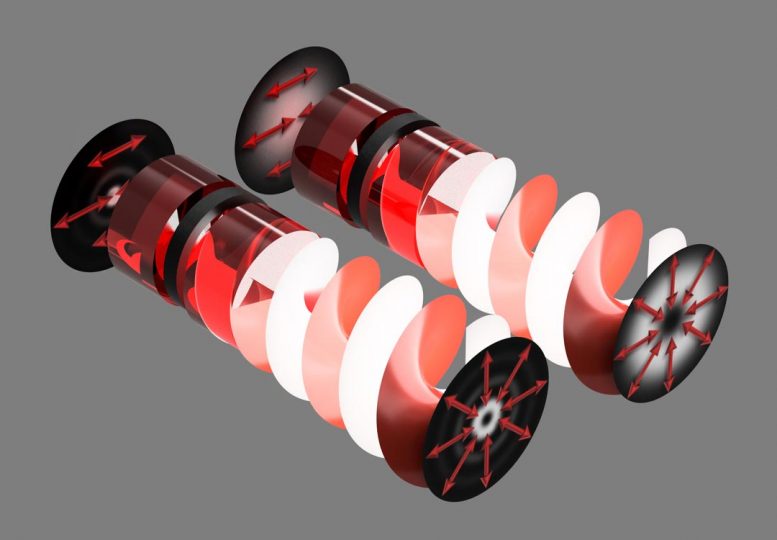
Quantum mechanics has come a long way during the past 100 years but still has a long way to go. In AVS Quantum Science, researchers from the University of Witwatersrand in South Africa review the progress being made in using structured light in quantum protocols to create a larger encoding alphabet, stronger security and better resistance to noise. This image shows the creation of hybrid entangled photons by combining polarization with a “twisted” pattern that carries orbital angular momentum. Credit: Forbes and Nape
Quantum mechanics is embracing patterns of light to create an alphabet that can be leveraged to build a light-based quantum network.
Structured light is a fancy way to describe patterns or pictures of light, but deservedly so as it promises future communications that will be both faster and more secure.
Quantum mechanics has come a long way during the past 100 years but still has a long way to go. In AVS Quantum Science, from AIP Publishing, researchers from the University of Witwatersrand in South Africa review the progress being made in using structured light in quantum protocols to create a larger encoding alphabet, stronger security and better resistance to noise.
“What we really want is to do quantum mechanics with patterns of light,” said author Andrew Forbes. “By this, we mean that light comes in a variety of patterns that can be made unique — like our faces.”
Since patterns of light can be distinguished from each other, they can be used as a form of alphabet. “The cool thing is that there are, in principle at least, an infinite set of patterns, so an infinite alphabet is available,” he said.
Traditionally, quantum protocols have been implemented with the polarization of light, which has only two values — a two-level system with a maximum information capacity per photon of just 1 bit. But by using patterns of light as the alphabet, the information capacity is much higher. Also, its security is stronger, and the robustness to noise (such as background light fluctuations) is improved.
“Patterns of light are a route to what we term high-dimensional states,” Forbes said. “They’re highly dimensional, because many patterns are involved in the quantum process. Unfortunately, the toolkit to manage these patterns is still underdeveloped and requires a lot of work.”
The quantum science community has made many recent noteworthy advances, both in the science and derived technologies. For example, entanglement swapping has now been demonstrated with spatial modes of light, a core ingredient in a quantum repeater, while the means to securely communicate between nodes is now possible through high-dimensional quantum key distribution protocols. Together they bring us a little bit closer to a fast and secure quantum network.
In a similar vein, the construction of exotic multiparty high-dimensional states for quantum computer has been realized, as has enhanced resolution in ghost imaging (produced by combining light from two light detectors). Yet it remains challenging to break beyond the ubiquitous two photons in two dimensions for full control of multiple photons entangled in high dimensions.
“We know how to create and detect photons entangled in patterns,” said Forbes. “But we don’t really have good control on getting them from one point to another, because they distort in the atmosphere and in optical fiber. And we don’t really know how to efficiently extract information from them. It requires too many measurements at the moment.”
Forbes and his co-author Isaac Nape helped pioneer the use of hybrid states — another big advance. Old textbook quantum mechanics was done with polarization.
“It turns out that many protocols can be efficiently implemented with simpler tools by combining patterns with polarization for the best of both worlds,” Forbes said. “Rather than two dimensions of patterns, hybrid states allow access to multidimensional states, for example, an infinite set of two-dimensional systems. This looks like a promising way forward to truly realize a quantum network based on patterns of light.”
Reference: “Quantum mechanics with patterns of light: Progress in high dimensional and multidimensional entanglement with structured light featured” by Andrew Forbesa and Isaac Nape, 29 October 2019, AVS Quantum Science.
DOI: 10.1116/1.5112027

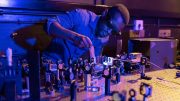
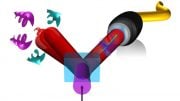
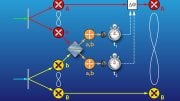
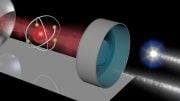


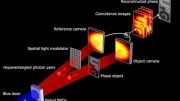
Be the first to comment on "Faster, More Secure Communications Using Structured Light in Quantum Protocols"